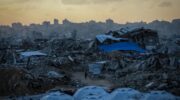Palestinian mother and children in Gaza, February 2001, during an Israeli closure. (Photo by Alison Weir)
While many Americans are inconvenienced, or in some cases suffering under coronavirus quarantining orders and isolation, the people of Gaza have suffered far longer under an Israeli-imposed quarantine that has caused malnutrition and growth stunting in children, deep poverty, and misery… and now, the virus has hit Gaza…
A Norwegian doctor writes: “Remember, this is not caused by drought or natural disasters, but a deliberate, man-made lack of food and water, imposed, planned, and executed in the most detailed way by the Israeli government. They even calculate how many calories to let in to Gaza to avoid outright starvation but to ‘just’ cause malnutrition since that goes under the radar of human rights abuses….”
By Alison Weir
Many Americans are grappling with the difficulties caused by the coronavirus epidemic and recent “shelter in place” orders in a number of states: people face isolation and can’t always obtain food and other necessities, while hospitals face scarcity of medical equipment and treatment space.
While U.S. news media regularly report on the challenges some countries face during this crisis, they have failed to acquaint us with the plight of families in the Palestinian territory of Gaza. This population has experienced severe isolation and scarcity for over 13 years, ever since 2007, when Israel imposed a blockade on the entire population of Gaza – now almost two million men, women, and children.
And, as we will see, regular closures of Gaza had already been going on for many years before that.
The blockade and closures – illegal under international law – have caused hardship far beyond what we’re experiencing in the U.S.
I’m in a household that includes three energetic young boys in one of California’s most impacted counties. We’re under shelter-at-home orders severely limiting our movements and ability to acquire food and materials. And before that, we had been self-quarantined for a week due to possible exposure to the coronavirus.
This is nothing compared to the situation in Gaza. An Israeli organization reports: “Israel has turned Gaza into the biggest open-air prison in the world. The Gaza Strip is now in the throes of a humanitarian disaster – created entirely by Israel.”
When I visited Gaza in early 2001, I saw a population already experiencing closures and the resulting growth of poverty and food insecurity. This has grown steadily worse.

Families in Gaza have been deprived of sufficient nutritious food, essential medicines, crucial operating room supplies, building materials, and other necessities. Their freedom of movement has been profoundly impaired, and the ability to live a normal life drastically curtailed.
In a recent report, Britain’s Oxfam charity revealed: “The blockade has devastated Gaza’s economy, caused widespread destruction and left most people largely cut off from the outside world. Today, one million Palestinians in Gaza don’t have enough food to feed their families, despite receiving food assistance or other forms of support.”
The UN reports: “Long-standing restrictions on movement of people and goods have led to a de-development of Gaza and have had a devastating effect on people’s lives.”
In May, Gaza’s deficit in medicine and medical supplies exceeded 52 percent.
The World Bank reported in 2018 that Gaza’s economy is in “free fall.”

What exactly is Gaza?
Before we go further, let’s briefly consider Gaza’s history, as well as its unique status in the world – both of which are largely unknown to most Americans.
The Gaza Strip (like the West Bank) is a remnant of a region that was called Palestine until 1948. [map]

That year saw one of the most massive (and underreported) ethnic cleansings of the 20th century. Military forces, largely composed of recently arrived colonists, armed themselves with weaponry provided by gun-runners in Europe and the U.S. These people then expelled hundreds of thousands of Muslims and Christians, who made up the large majority of Palestine’s inhabitants.
The colonists’ objective was the creation of a new state for Jews only.
Leaders of the new country then decided to name it “Israel” – after two kingdoms that had existed on part of the land over 2,000 years before and that had lasted about 250 years.
Israel had managed to capture 78% of the land that had been Palestine. The 22% that remained in Palestinian hands included the West Bank and Gaza.
The Israeli government intended to expand its territory, and therefore did not declare its borders after the 1948 war (the Israeli “border” was actually the 1949 armistice line called “the Green Line”). It has still not defined its borders to this day.
In 1967 Israel launched the Six Day War, in which Israel gained military control over the rest of Palestine: Gaza and the West Bank.

Gaza: Occupied Palestinian Territory
In today’s world, obtaining land by military force is illegal under international law, and the Israel government does not claim that Gaza is part of Israel. Instead, Gaza has been under what’s termed “belligerent occupation“ by Israel.
As the occupation dragged on, Israel steadily confiscated more and more Gazan land, turning it into Jewish-only settlements that belonged to Israel (land in the West Bank was similarly confiscated). This is illegal under international law.
Finally in 2005, Israel “disengaged” from Gaza. It withdrew these settlers, abandoned its illegally acquired land, and moved its soldiers to the perimeter. While Israeli soldiers no longer impose checkpoints and patrols within Gaza itself, most legal scholars, humanitarian agencies, and countries around the world consider Gaza still occupied because of Israel’s total land, sea, and air control over the area.
Israeli soldiers continue to regularly shell Gaza, attack and confiscate Gazan fishing boats, and perpetrate military raids inside Gaza. Israel continues to control Gaza’s sea border, northern border, eastern border, and, through the collaboration of Egypt, its southern border.
Some groups in Gaza have periodically resisted Israeli actions, using both nonviolent and armed resistance.
While the armed resistance has killed some Israeli civilians, most people are unaware that Palestinians have killed vastly fewer Israeli civilians than Israeli forces have killed Gazan civilians.
Gaza rockets, for example, which are virtually always mentioned in US news reports, have since 2001 killed a total of 30 Israelis, while Israeli airstrikes have killed over 5,800 Gazans.
When Gazans in 2006 elected a Hamas government*, Israel instituted more closures, and the following year, citing “security concerns,” imposed a land, air, and sea blockade on the entire Gaza strip. Even though this has periodically lessened, it continues through today.
Two and a half decades of Israeli closures of Gaza
Even before the official blockade began in 2007, Israeli closures had been causing hardship for many years. Israel has imposed movement restrictions on the Gaza Strip since at least the early 1990’s.
When I was in Gaza in February and March of 2001, I observed this first hand. Israel had largely closed off Gaza and very few people were being allowed in or out.
During this time Gaza was being shelled nightly. The Palestinian uprising called the “second intifada” had begun and Israeli forces were using live gunfire, F-16s, helicopter gunships, tanks, etc. to try to suppress it, killing numerous children.
In Gaza I saw entire neighborhoods that were bullet-riddled, family dwellings damaged and destroyed. There was nothing even close to that in Israel.

I talked to farmers whose orchards had been leveled. I spoke with a woman who was the only one still working in an extended family of 40. I interviewed a woman living in a tent, because her home had been destroyed. She asked me to tell Americans about her.

I saw children who had been shot by Israeli soldiers.

While Israel and its supporters often rationalize Israeli violence as “self-defense” against Gazan rockets, it is crucial to note that, in addition to the rarely lethal nature of these rockets (as discussed above), at this point in 2001 no rockets had been launched from Gaza.
While in Gaza, I submitted eyewitness reports to the San Francisco Chronicle, but an editor told me they were “too political” to publish. When I returned and gave talks about what I had seen, Israel partisans called me “antisemitic.”
A long chronicle of Israel-caused deprivation
A number of humanitarian agencies described the malnutrition that Israel’s closures were causing.
In March 2002, Christian Aid reported that two clinics run by the Middle East Council of Churches for women and children in Gaza City had treated 590 cases of child malnutrition and rising rates of infection, anaemia, and other diseases. Another medical charity reported that it had treated 5702 children under five for malnutrition, double the previous year.
In April 2002, the UN Food and Agriculture Organization stated that the total blockade of the West Bank and Gaza had had paralyzed the Palestinian economy, “with millions of people severely impoverished and food insecure.” It reported that “malnutrition is on the increase.”
In 2004, the Independent revealed: “Malnutrition rates in the Gaza Strip and parts of the West Bank are as bad as those in sub-Saharan Africa, MPs said yesterday. They warned that the Israeli security fence around the occupied territories was ‘destroying the Palestinian economy and creating widespread poverty’.”
In 2006 the Guardian quoted Dov Weisglass, adviser to Israeli Prime Minister Ehud Olmert saying: “‘The idea is to put the Palestinians on a diet, but not to make them die of hunger.” The Guardian explained the strategy: “The hunger pangs are supposed to encourage the Palestinians to force Hamas to change its attitude towards Israel or force Hamas out of government.” This is collective punishment and illegal under international law.

In 2008, the UK Independent reported on a leaked Red Cross account of the Israeli blockade:
“People are selling assets, slashing the quality and quantity of meals, cutting back on clothing and children’s education, scavenging for discarded materials – and even grass for animal fodder – that they can sell and are depending on dwindling loans and handouts from slightly better-off relatives.”
The Red Cross found that the “devastating” effect of the siege had “triggered a shift in diet that will damage the long-term health of those living in Gaza and has led to alarming deficiencies in iron, vitamin A and vitamin D.”
“Approximately 106,000 employees lost their jobs after the shutdown and about 40 per cent were classified as ‘very poor’, earning less than 500 shekels (£87 [or $138]) a month to provide for an average household of seven to nine people.”
The article reported: “In agriculture, on which 27 percent of Gaza’s population depends, exports are at a halt and, like fisheries, the sector has seen a 50 per cent fall in incomes since the siege began,” and quoted the Red Cross report as saying, “People’s coping mechanisms are very limited and those households that still have jewelry and even non-essential appliances sell them.” The report also indicated that if Israel prolonged the embargo, “economic disintegration will continue and wider segments of the Gaza population will become food insecure.”
In January 2009 the Red Cross reported that most people in Gaza “struggle to make ends meet. Seriously ill patients face difficulty obtaining the treatment they need. Many children suffer from deep psychological problems. Civilians whose homes and belongings were destroyed during the [December 2008-January 2009] conflict are unable to recover.”
The Red Cross stated that the increase in poverty “has taken a heavy toll on the population’s diet. For tens of thousands of children, this has resulted in deficiencies in iron, vitamin A and vitamin D. The likely consequences include stunted growth of bones and teeth, difficulty in fighting off infections, fatigue and a reduced capacity to learn.”
In 2010 the Red Cross called the blockade illegal and called on Israel to end it.
Israel ignored these reports, American politicians continued to vote massive amounts of money to Israel, and the blockade continued.
NGOs continue to bear witness
Recent reports by humanitarian organizations point out the persistence of Gaza’s struggles.
In 2015, 35 humanitarian organizations around the world called for Israel to end the blockade, and an associated petition was immediately signed by almost half a million people.
In 2018 Amnesty International called on Israel to end the blockade on Gaza, and my organization called for Israel to allow medical supplies into Gaza to treat 1,700 people with shattered limbs (from bullets fired by Israeli soldiers) who were likely to need amputations if Gaza didn’t receive emergency help.
Oxfam reported in 2018 that ever since the blockade, Gaza “fishermen have only been allowed to fish just six nautical miles or less offshore. With most of the fish at least nine miles out at sea, they have already been struggling to make a living and now 90 percent of them need international aid.”
Another Oxfam report states: “Israel’s blockade of Gaza severely limits materials from entering, making it incredibly difficult to develop water and sanitation infrastructure to meet the needs of a growing population.”
Fewer than 16% of items needed to construct vital water infrastructure are reaching Gaza. As a result, “less than four percent of Gaza’s fresh water is drinkable.”
The UN reported in 2019, “The Gaza Strip faces a chronic humanitarian crisis, impacting the livelihoods and access to essential services by its two million residents. Unemployment is nearly 75 per cent. 70 percent of the population is food insecure.”
Beyond oppression: Israeli attacks on Gaza
Since 2008, Gazans have experienced three major Israeli invasions, which the media called “wars.” In these “wars,” Israeli forces killed 3,782 Palestinians, while Palestinians killed 87 Israelis. During these attacks, Israeli forces destroyed thousands of Palestinian homes, businesses, and farms.

One of Israel’s stated reasons for starting these wars was to force the Gazan resistance to stop firing rockets toward Israel. Before these invasions, rockets had killed a total of 12 Israelis. They had been launched in response to Israeli violence.
In a 2012 article entitled, “Every third child in Gaza stunted by hunger,” renowned Norwegian doctor Mads Gilbert – who had been in Gaza during the first of these incursions – said:
“The character of the Israeli military attacks was unbelievably brutal and disproportionate. The attack on Gaza’s civilian infrastructure and population, the repeated use of illegal weapons like white phosphorus bombs, and the testing of new and extremely destructive US-manufactured weapons like the DIME [Dense Inert Metal Explosive] and other “small diameter bombs” all indicated that Israel used its force unjustifiably and disproportionately, clearly in violation of the international laws of war and humanitarian rules.”
Gilbert went on to describe the medical consequences for children:
“As a result of the Israeli siege, there has been widespread development of anemia among children and women due to malnutrition as a result of siege and poverty. Stunting, where a child is more than two standard deviations shorter than what it should be, is sharply on the rise. In 2006, around 13.5 percent of children were stunted. In 2009, 31.4 percent under age two were stunted.
“In other words, every third child is less developed than he or she should be. And stunting does not only affect growth. It also affects brain development and the ability to learn. This is a direct consequence of malnutrition.”
Dr. Gilbert continued:
“Remember, this is not caused by drought or natural disasters, but a deliberate, man-made lack of food and water, imposed, planned, and executed in the most detailed way by the Israeli government. They even calculate how many calories to let in to Gaza to avoid outright starvation but to ‘just’ cause malnutrition since that goes under the radar of human rights abuses.”
In addition, Israel often prevents vital international aid from entering Gaza.
Coronavirus could be a death sentence for Gaza
And now the coronavirus has hit Gaza, which has a total of 62 ventilation devices for a population of almost 2 million. More than two-thirds of the devices are already used by other patients. Nine Gazans have tested positive for the virus, and there are concerns about what will happen if/when the virus spreads.
The Nation points out that social distancing is extremely difficult in Gaza, where densities are up to 85,628 people residing in a 0.2 square mile area. The article reports that “Gaza’s eight refugee camps, the systems organized to save lives…will undoubtedly become lethal bottlenecks, petri dishes for the deadly virus.”
An article in the Forward reports: “X-Ray, CT, MRI machines, and intensive care equipment are old. Power fluctuations due to the electricity crisis in Gaza have damaged hundreds of medical machines. Without the ability to import new necessary devices or repair broken ones, the blockade sentences Gaza’s medical sector to failure.
“The coronavirus combined with the population’s poor health and inadequate medical system mean that an outbreak in Gaza is unlikely to be contained and hospitals would be unable to treat patients. In other words, it would be a death sentence.”
The Israeli organization B’Tselem stated: “The spread of COVID-19 in the Gaza Strip will be a massive disaster, resulting entirely from the unique conditions created by more than a decade of Israeli blockade: a failing healthcare system, extreme poverty, dependence on humanitarian aid, dysfunctional infrastructure and harsh living conditions that compromise public health – even before exposure to the new virus – combine with overcrowding to form a nightmare scenario.”
Fourteen American Christian denominations, including Presbyterian, Episcopalian, Methodist, Lutheran and others, sent a public letter to President Trump, Treasury Secretary Mnuchin and Secretary of State Pompeo calling for an end to the blockade:
“The strict Israeli blockade of Gaza, imposed with U.S. support, has already made conditions “unlivable” for the residents of Gaza, apart from COVID-19. The UN and other international agencies have repeatedly called attention to shortages of key medicines and medical supplies, with up to 50% of basic medical supplies unavailable at any time. Population density, broken water and sanitation systems, and a under resourced medical system leave Gaza vulnerable to an uncontrolled COVID-19 outbreak that could also negatively impact Israel. Israel regularly denies permits to patients seeking medical care that is available only outside Gaza and when permission is granted, Israel often denies permits for accompanying family members, especially for parents of children. The U.S. should end its support for the blockade of Gaza and immediately press Israel to ensure that medical supplies and technology are provided to Gaza, that patients needing treatment outside of Gaza are given the permits necessary for extended periods of treatment, and that family members, especially parents accompanying children, are also granted permits to travel.”
Time to demand change
For over 13 years, Israel has withheld food, medical supplies, electricity, and other necessities from the people of Gaza. This blockade is illegal. If there was ever a time to pressure Israel to end this policy, it is now – when the coronavirus threatens the very existence of this oppressed population.
U.S. politicians from both parties have voted to give Israel Israel over $10 million per day. That works out to over $7,000 per minute, and they’re currently considering legislation that would give Israel at least $38 billion in the next 10 years. (This works out to about $23,000 per every Jewish Israeli family of four).
Maybe it’s time for these Congress members to demand that Israel end its blockade of Gaza. If you agree, please go here.
—-
*Hamas, like all governments, has both a political and a military arm. As noted above, the military arm has killed far fewer civilians than the Israeli military. While the US government has included Hamas in its list of terrorist organizations, it is important to be aware that the decision about whom to include on this list and whom to omit is often political. Hamas has often offered longterm ceasefire, which Israel rejects. In addition, Israel is the party that most frequently breaks the periods of calm, another fact rarely reflected in US news coverage.
Alison Weir is executive director of If Americans Knew, president of the Council for the National Interest, and author of Against Our Better Judgment: The Hidden History of How the U.S. Was Used to Create Israel.
Our operations are funded solely by generous individuals like you. Your contribution will help us continue shining a light on the Israel/Palestine situation and the U.S. connection.
DONATERelated:
No, life during the coronavirus isn’t like Gaza
Israeli airstrikes vs Palestinian rockets: Facts & Stats on air attacks
Facts & latest news on Gaza Great March of Return
International flotillas attempt to take humanitarian supplies to Gaza





